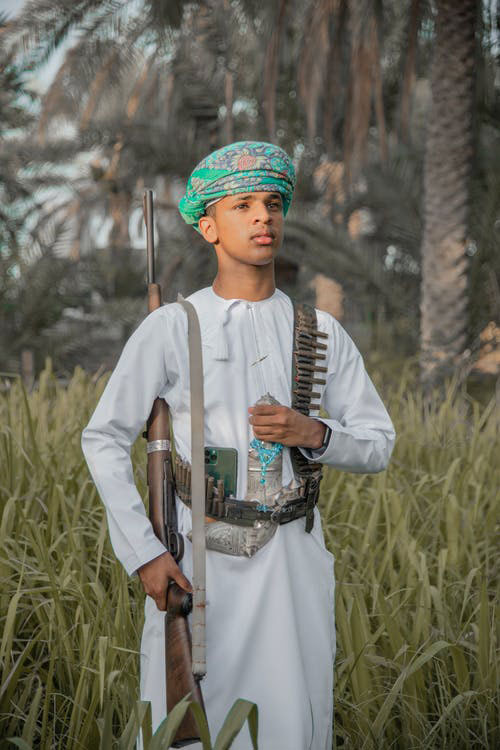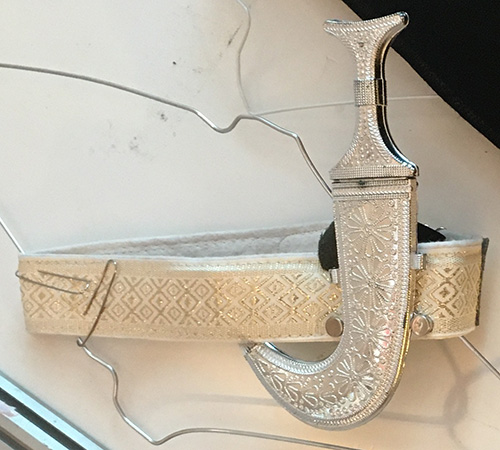 We can find various dress knives that are an integral part of traditional costumes throughout the world. In the Arab world, a khanjar dagger is The One. Its curious shape and opulent décor make this traditional knife a beautiful and sought-after male accessory. Like women dream about gold and silver jewelry, every Omani man wants to own a khanjar, and as ornate as possible. But this ceremonial dagger is not a toy or just a costly adornment, it’s a symbol of manhood, power, and authority, deeply meaningful and symbolic.
We can find various dress knives that are an integral part of traditional costumes throughout the world. In the Arab world, a khanjar dagger is The One. Its curious shape and opulent décor make this traditional knife a beautiful and sought-after male accessory. Like women dream about gold and silver jewelry, every Omani man wants to own a khanjar, and as ornate as possible. But this ceremonial dagger is not a toy or just a costly adornment, it’s a symbol of manhood, power, and authority, deeply meaningful and symbolic.
A khanjar, also spelled as “xencer”, “khôñjôr”, “hançer”, “handžar”, “handschar”, etc, is a traditional dagger shaped like the letter “J”. It is popular in many Arab countries, including Yemen, the UAE, and Qatar, but this dress knife actually originates from Oman.
This dagger is featured on Oman's national emblem and on the Omani rial. Also, it’s a very meaningful item in Omani folk culture.
When did khanjar first appear?
The origins of the Omani khanjar remain uncertain, but ancient rock carvings depicting this distinctive dagger have been discovered on gravestones in the central region of the Musandam Peninsula (Northwestern point of the Arabian Peninsula). These carvings are believed to predate the late 1700s. Additionally, an account by Robert Padbrugge from the Dutch Republic, who traveled to Muscat in June 1672, also mentions the Omani khanjar.

Very beautiful ornate khanjar worn by Omani young man
The influence of the Ottoman Empire played a significant role in spreading the use of this type of knife. In the Balkans, it was known as the “handschar”, and Ottoman policemen were known to carry these knives regularly. Even after the end of Ottoman rule, the “handschar” remained in local use.
What is it made from?
The Omani khanjar's craftsmanship determines the choice of materials used, resulting in a wide variety of options. For exquisite quality, khanjars meant for royalty are crafted using gold or silver. On the other hand, local artisans often employ brass and copper when creating daggers. Historically, gold-adorned sheaths and ivory handles and sheaths were used by upper-class men and indicated their social status. Prominent figures in Oman typically carry two khanjars.
Traditionally, the owner of the khanjar designs the dagger, providing specifications and preferences to the craftsman. The manufacturing process can span from three weeks to several months. The handle and blade form the essential components of the khanjar, and the material used for the handle significantly influences the final price of the dagger. In the past, rhinoceros horn and ivory were commonly used due to their superior quality as hilt materials. However, with the international ban on the ivory trade and rhinoceros horn, materials such as wood, plastic, and camel bone have gained prevalence. The top of the hilt is typically flat, although khanjars designed for the royal family feature a cross-shaped hilt.
Symbolic meaning of this dagger
The Omani khanjar is traditionally worn tucked underneath a waist belt, positioned prominently at the front and center of the wearer's body. While it was once part of everyday attire, nowadays it is primarily carried as a ceremonial dagger, reserved for formal events and special occasions such as weddings, parades, meetings, and diplomatic functions.
The khanjar symbolizes manhood, power, authority, and serves as a status symbol for the wearer. It is not uncommon for families to gift the khanjar to their sons upon reaching adolescence, and it is a popular wedding gift for grooms.
Although the khanjar's original purpose was for offensive and defensive use as a weapon, it now serves solely for ceremonial and practical functions. In practical scenarios, such as in the desert, it is utilized as a tool for hunting and skinning animals, as well as cutting ropes. Due to this evolution, it is considered a social taboo in Oman to draw one's khanjar from its scabbard without drawing blood. This is because pulling out the dagger is traditionally associated with seeking vengeance or self-defense, and these circumstances are the only acceptable reasons for unsheathing it.
Khanjar outside of Oman
This traditional dagger is a part of Omani folk attire and is often seen carried by Omani men. But this country is not the only one where you can find a khanjar. It is also a common dress knife in Yemen, the United Arab Emirates, Qatar, and other countries of Eastern Arabia.

Cheaper and simpler khanjar made for tourists
Today, Arab craftsmen produce a lot of cheaper and simpler khanjars for tourists. But at the same time, they offer real masterpieces to Omani men, beautifully crafted and richly embellished. This dagger is a national symbol of Oman and it is highly estimated by the locals as a significant piece of their cultural heritage.


